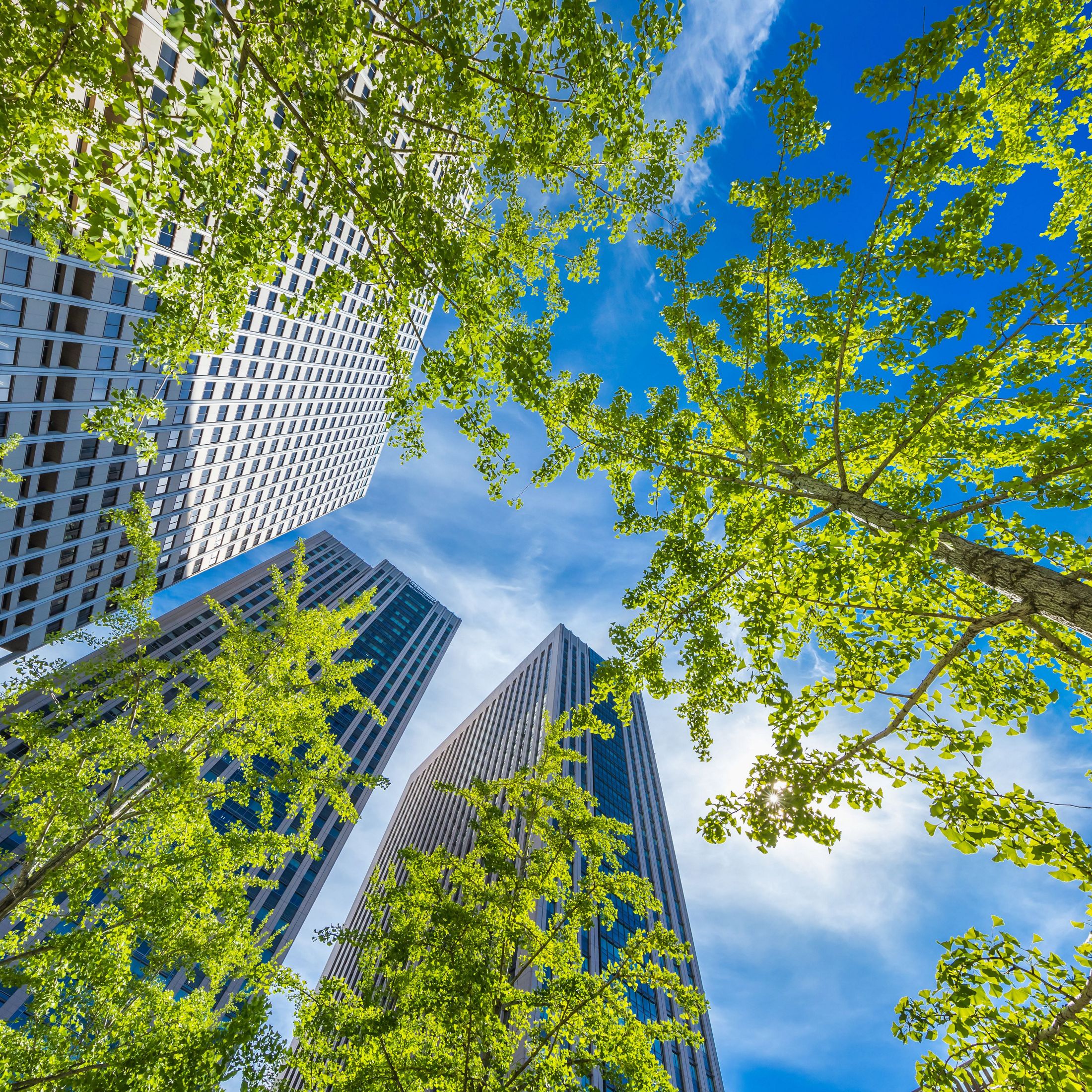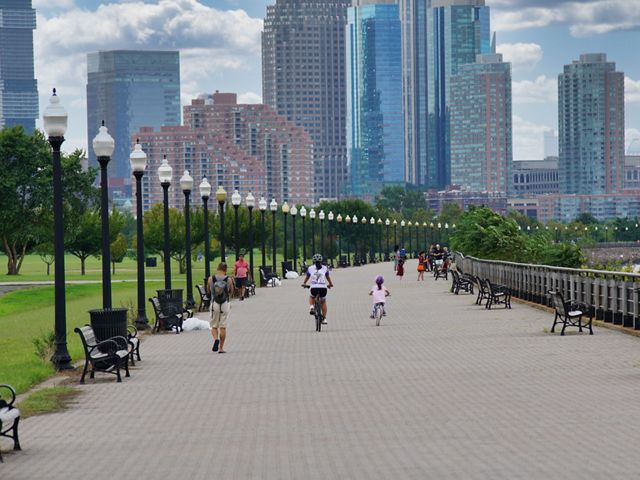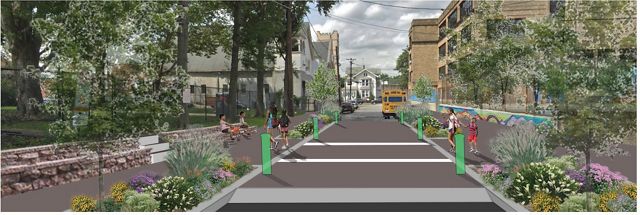
Urban Conservation in New Jersey
TNC is working in two of New Jersey's largest cities to increase community resilience in the face of climate change.
Explore conservation projects in Newark and Paterson
New Jersey has the fourth smallest area of any U.S. state at just 8,722 square miles, yet it is the most densely populated in the nation, with large suburbs of both New York City and Philadelphia. It is no wonder, then, that 93.8% of its communities are classified as urban by the U.S. Census Bureau, nearly 14% above the nationwide average. This makes the concept of urban conservation critical in our small but mighty state.
Cities are an essential part of New Jersey’s vitality. Beyond being vibrant cultural and economic centers, they reduce sprawl and habitat conversion, and their residents have a lower carbon footprint—important positive contributions as we face climate challenges and species loss. But many cities also struggle with inadequate and aging infrastructure, traffic, industrial waste and short-sighted development that replaced habitat along rivers and other important green spaces with concrete. These factors worsen air and water pollution, heat and flooding, contributing to human health problems and putting a strain on plants and animals.
Many cities are home to emerging communities, where people of lower income have for too long disproportionally borne the brunt of polluted air and water. Changing climate conditions intensify these impacts. The Nature Conservancy’s mission to conserve the lands and waters on which all life depends includes addressing the conservation needs of people living urban areas in New Jersey.

To fulfill our mission to conserve the lands and waters on which all life depends, The Nature Conservancy in New Jersey is addressing the conservation needs of urban areas, while putting people and community at the center of our work.
1. Community Engagement: TNC's urban conservation strategies are guided by the knowledge and voice of local residents for impactful and inclusive results.
2. Using Nature to Solve Challenges: Our approach prioritizes nature-based projects that help alleviate flooding and other hazards while making waterways healthier and expanding green space for residents.
3. Trees as a Tool: Restoring and expanding urban tree canopies decreases extreme heat islands, cools public areas, connects people with nature and provides space to welcome birds and pollinators.
4. Data-Driven Decision Making: Partnerships with academic institutions, other non-profit groups and community scientists produce high-quality data that we can use together to plan where nature can make the most positive impact in cities, and what programs and policies are needed to support nature as a solution to urban challenges.
TNC is collaborating with leaders from two of New Jersey’s largest cities to reduce urban heat, improve air quality, alleviate flooding and increase community resilience.
City Spotlight
Newark
Newark is New Jersey’s most populous city and is part of a U.S. Census Bureau grouping (with Jersey City and New York City) that is the largest and 4th densest urban area in the country. Arts, industry, education and sports thrive in Newark, but the city also faces some tough environmental challenges. In 2019, the tree canopy in Newark was measured at approximately 13.5%, far below the recommended amount for the Northeast and the national average of 27%. Since then, the city has been losing more than 1,000 trees per year. It is not surprising, then, that in 2022 Newark was found to contain the second-worst heat islands of any city in the United States.
A prioritization process between TNC and Newark’s community leaders has focused on improving heat islands through natural greening. Trees have added benefits of filtering pollutants and absorbing floodwater while improving quality of life for residents with a proven range of health, environmental, recreational and economic benefits.
The Newark Greenprint
The City of Newark’s Office of Sustainability, Rowan University and The Nature Conservancy collaborated to create The Newark Greenprint, with support from the PSEG Foundation and the Federal Emergency Management Agency’s Cooperating Technical Partners Program.
This free online tool provides ecological insights and mapping to empower smart, resident-driven change and growth for the city. Users have access to information about open spaces, environmental health metrics, natural resources and physical and environmental risks. They can also view spatial data comparing the physical and built environment, as well as visualize what a network of interconnected green spaces—such as parks, urban farms, street trees and community gardens—throughout the city could look like.

Planting Trees
In 2023, TNC teamed up with the non-profit Branch Brook Park Alliance, Essex County government, elected officials, New Jersey Institute of Technology and other volunteers to plant 200 trees in 360-acre Branch Brook Park, located in Newark’s North Ward. Continued partnership will address flooding issues, restore habitat and enhance recreation for people locally.
TNC partnered with Newark’s Office of Sustainability and was awarded a $1.3 million from NJDEP’s Natural Solutions Grant Program for Newark’s Urban Canopy Initiative to plant and maintain 331 trees; in September 2023, TNC was awarded $8 million from the United States Department of Agriculture Forest Service for greening initiatives in the city.

City Spotlight
Paterson
The third most populous city in New Jersey, Paterson has a rich history and role in the Industrial Revolution powered in part by the Passaic River’s Great Falls at its heart. Water, it seems, is one of the community’s greatest assets and most problematic challenges. As of 2021, 11% of all urban land use areas in Paterson was located within a flood hazard area and the city also has approximately 22 combined sewer overflows that discharge untreated wastewater and stormwater during heavy rain or snowmelt. Localized flooding, when mixed with sewer backfills, can result in harmful impacts to human health and property.
TNC is supporting Paterson decision makers and stakeholders to increase natural features in the city that can help mitigate these impacts, while at the same time enhancing access to nature and its many benefits for residents.
Fair Street Green Street
We have partnered with the Paterson Flood Fighters, Rutgers Water Resources Program, and the City of Paterson on the design and construction of Fair Street Green Street, a project to reduce stormwater runoff. The installment will include rain gardens, bioswales, enhanced tree pits and permeable pavement—all elements that capture and filter stormwater during rain events, before it can strain the sewer system and cause flooding. The Fair Street project is supported and funded by Clean Water Act Section 319(h) funds through New Jersey’s Department of Environmental Projection.

Clinton Street Park
The Cities Team is supporting Passaic County Habitat for Humanity on the creation of Clinton Street Park, a park in the City’s 1st ward. Clinton Street Park is a formerly vacant one-acre site near PS28. The community co-created the design of the park together with Passaic Habitat for Humanity and Arterial design studio, including play equipment, performance space, and game tables. TNC is providing technical assistance and funding the installation of green features including newly planted trees, which will provide shade, reduce heat, and help absorb stormwater and prevent it from running off into local streets and the city’s combined sewer overflow system.

More Paterson Support
To empower stakeholders in Paterson to promote smart development, TNC is engaging community collaborators in developing a mapping tool based on the Newark Greenprint model. Financed in part by the Federal Emergency Management Agency’s Cooperating Technical Partners Program, the free, interactive, web-based tool will be a critical resource for environmental, public health and sustainability data. It will help users identify areas of ecological need, map green spaces and plan for future greening projects that improve community resilience and quality of life. Our Cities Team is working to identify community groups and partner organizations that will collaborate on the development of this tool.
We are also partnering with the Great Swamp Watershed Association to engage and educate citizen volunteers through Adopt-a-Catch Basin, a project to alleviate flooding and beautify neighborhoods by reducing debris and trash on sewer grates, and teaming up with leaders in Paterson to increase nature on public school yards.
Meet our Team
TNC’s team dedicated to conservation in New Jersey’s cities a promotes an integrated and inclusive approach to conservation that recognizes the importance of both environmental and social sustainability.

Adopt A Catch Basin
The Nature Conservancy and Great Swamp Watershed Association launched an innovative volunteer program to create a healthier Paterson by reducing street flooding. Cleaner catch basins can help to reduce localized flooding and keep plastics and debris out of our stormwater. Learn more and find out how you can get involved!
Our Cities Work
North America Cities Network
Cities are home to more than 62% of the U.S. population. To fulfill our mission, The Nature Conservancy must address the conservation needs of these areas.






